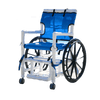Essential Safety Tips for Wheelchair Users on Public Transportation

Using public transportation while in a wheelchair offers greater independence, but ensuring safety is crucial. This blog highlights key tips and safety measures to help wheelchair users navigate public transportation securely and comfortably.
Know Your Rights
Under the Americans with Disabilities Act (ADA), public transportation systems are required to provide accessible services, including ramps, lifts, and designated spaces for wheelchair users. Knowing your rights under the ADA can empower you to advocate for the accommodations you deserve, such as accessible vehicles and assistance from transit staff (U.S. Department of Transportation, 2021). Familiarize yourself with the transit policies in your area, as they may vary by city or state.
Secure Your Wheelchair
One of the most critical aspects of wheelchair safety on public transportation is securing your chair properly. Ensure that your wheelchair is fastened using the available tie-down straps or docking systems, which prevent movement during transit. Many buses and trains offer these features, but it's essential to check that they are working properly before your trip (Transportation Research Board, 2021). If you’re unsure, ask the driver or conductor for assistance.

Plan Your Trip
Planning ahead can make your trip smoother and safer. Research the accessibility features of the public transportation system you’re using, including wheelchair-accessible routes, vehicles, and stops. Many transit websites and apps provide up-to-date information about accessible stations, ramps, and elevators, making it easier for wheelchair users to plan their journeys (ADA National Network, 2021). Consider calling the transit provider in advance to confirm accessibility and learn about any changes to services.
Additional Tips for Wheelchair Users:
- Communicate with Transit Staff: Let drivers or transit staff know if you need assistance, such as securing your wheelchair or lowering the bus ramp. Most public transportation workers are trained to assist passengers with disabilities.
- Wear a Seatbelt: If your wheelchair has a seatbelt, always wear it while traveling. It provides added security in case of sudden stops or movements.
- Avoid Rush Hours: Traveling during peak times can be more stressful due to crowded conditions. If possible, plan trips during off-peak hours to ensure more space and accessibility.
Conclusion
By knowing your rights, securing your wheelchair, and planning your trip in advance, you can confidently and safely use public transportation. For personalized advice, consult transportation experts and review ADA guidelines to stay informed. Always prioritize safety and communicate with transit staff if you need assistance.
Visit Dansons Medical for a range of high-quality and reliable medical equipment and resources to support your health. Let us be your partners in promoting a healthier and more comfortable lifestyle for individuals with disabilities.- Dansons Medical Support


 Lifts
Lifts
 Patient Lifts
Patient Lifts
 Stand Assists
Stand Assists
 Standing Aids
Standing Aids
 Slings
Slings
 Parts & Accessories
Parts & Accessories
 Wheelchairs
Wheelchairs
 Ergonomic
Ergonomic
 Portable
Portable
 Reclining
Reclining
 Standing
Standing
 Sporting
Sporting
 Bariatric
Bariatric
 Ramps
Ramps
 Modular
Modular
 Portable
Portable
 Parts & Accessories
Parts & Accessories
 Walking Aids
Walking Aids
 Rollator Walkers
Rollator Walkers
 Canes
Canes
 Crutches
Crutches
 Parts & Accessories
Parts & Accessories
 Scooters
Scooters
 4-Wheel
4-Wheel
 Folding
Folding
 Parts & Accessories
Parts & Accessories
 Nursing
Nursing
 Pregnancy Comfort
Pregnancy Comfort
 Self-Care
Self-Care
 Pump Parts
Pump Parts
 Exercise Equipment
Exercise Equipment
 Treadmills
Treadmills
 Walking Pads
Walking Pads
 Rowing Machines
Rowing Machines
 Strength & Conditioning
Strength & Conditioning
 Massage Chairs
Massage Chairs
 Saunas
Saunas
 Hot & Cold Tubs
Hot & Cold Tubs
 Stethoscopes
Stethoscopes
 Surgical Instruments
Surgical Instruments
 Forceps
Forceps
 Scalpels
Scalpels
 IV Poles
IV Poles
 Oxygen
Oxygen
 Beds
Beds
 Electric Beds
Electric Beds
 Standing Beds
Standing Beds
 Mattresses
Mattresses
 Bed Accessories
Bed Accessories
 Bed Parts
Bed Parts
 Chairs
Chairs
 Medical Recliners
Medical Recliners
 Phlebotomy Chairs
Phlebotomy Chairs
 Stools & Task Chairs
Stools & Task Chairs
 Parts & Accessories
Parts & Accessories
 Tables
Tables
 Overbed Tables
Overbed Tables
 Medical Tables
Medical Tables
 Recovery Couches
Recovery Couches
 Cabinets
Cabinets
 Pool
Pool
 Pool Lifts
Pool Lifts
 Pool Fitness & Therapy
Pool Fitness & Therapy
 Pool Access Chairs
Pool Access Chairs
 Slings
Slings
 Parts & Accessories
Parts & Accessories
 Bath
Bath
 Toileting Aids
Toileting Aids
 Bath Lifts
Bath Lifts
 Shower Seats
Shower Seats
 Parts & Accessories
Parts & Accessories
 Portable Shower
Portable Shower
 Dansons Products
Dansons Products
 Transfer Aids
Transfer Aids
 Cushions
Cushions
 eBooks
eBooks
 Helpful Articles
Helpful Articles
 Reviews
Reviews
 Contact Us
Contact Us
 Create Account
Create Account
 Request a Quote
Request a Quote

Comments 0